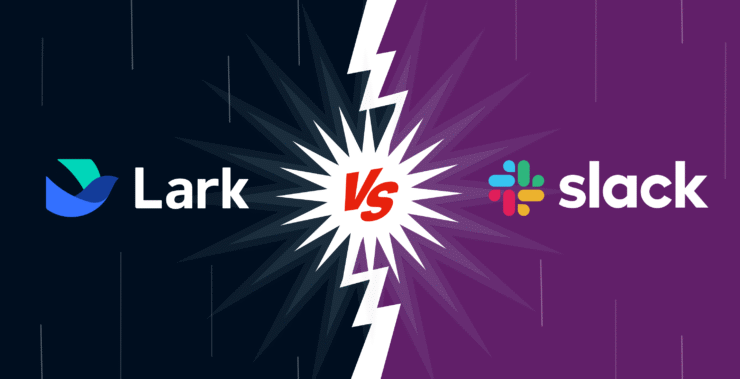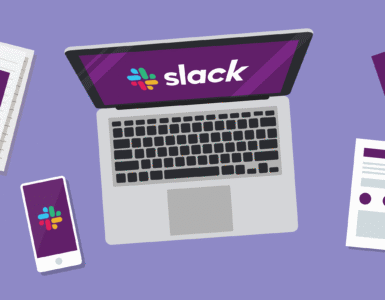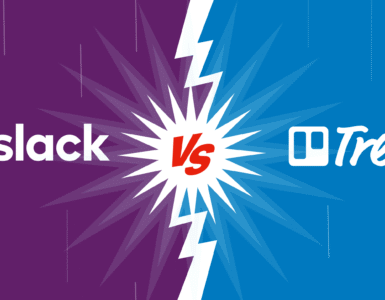You’ve probably been in a situation where your team’s communication tools felt like a jigsaw puzzle – each piece promising a different solution, but none quite fitting together perfectly. Maybe you’ve tried juggling multiple platforms for chatting, file sharing, and project management, only to find that they don’t quite click. That’s the dilemma many teams face when deciding between tools like Slack and Lark.
While both Slack and Lark promise to enhance collaboration, each of them is doing so in their own way. Slack is the Swiss Army knife of communication: versatile, customizable, and always ready to integrate with something new. On the other hand, Lark is an all-in-one workspace that easily slides from conversation to video call into a document and back again – without opening a new tab.
But what if you’re looking for something that offers the simplicity of Lark with the flexibility of Slack? That’s where Chanty comes in. It offers a streamlined approach to team communication – combining seamless messaging, task management, and file sharing without the need for third-party integrations, helping you avoid the chaos of juggling multiple tools.
Which will your team choose? The best choice depends on your workflow, size, and what is best for your team’s way of doing work. That said, let us dive deeper into how those two offerings compare regarding functionality, purpose, and areas of application. This will make your decision easier without the discomfort associated with having to switch through open tabs.
Slack vs Lark: Purpose and Use Cases
When choosing between Slack and Lark, it’s important to understand the “why” behind each tool.
Slack firmed its position as an undisputed powerhouse in communications, while teams that thrive on flexibility benefit from this tool. From small-scale startups to highly scaled-up enterprises, Slack fits into any mold. Its open design invites one to create workflows that work for the team, be it project channels, client communications, or even casual banter. Slack is at its best when integrated with the myriad of tools that your team has been using. In case the nature of your work requires you to toggle between different software for managing projects, scheduling on calendars, or even sharing documents, Slack ensures everything can be kept on a single platform with the least hassle.
But that’s not all: It is not only about making things easier, it’s about making things more effective. The strength of Slack lies in its ability to scale: you can start small with a few channels and integrations, and as your team grows, Slack can grow with you. To companies relying on speed and constant connectivity, such as tech startups, marketing teams, or anyone focusing hard on external collaboration, Slack offers flexibility to work on your terms.
On the other hand, Lark provides an integrated workspace for redefining collaboration in a single entity. With video calls, document collaboration, and task management all wrapped under one single platform, it avoids constant app hopping. If your team wants a streamlined approach, this is what Lark offers. It would be of more value for global teams or companies managing flows across time zones. This feature of in-built translation allows smooth communication with colleagues in different languages and thus is the first choice for international businesses.
Speaking of simplicity, Lark is an outright winner. As much as Slack can be incredibly flexible, Lark is more integrated. If you like to keep all your stuff in one place, without extra integrations and third-party apps, then Lark gives you that without clutter. It’s perfect for companies that want a minimum but effective solution to handle everything from document sharing to project tracking without overwhelming the user.
- Both have their strong suits: Slack does great when integration and customization are kings, while Lark is great when simplicity and an all-in-one approach are in the spotlight. It all comes down to what your team needs: rapid scaling, external collaboration, or a more cohesive workspace.
For teams looking for the perfect balance of simplicity and productivity, Chanty offers an ideal solution. It combines ease-of-use with powerful features like Kanban task management and seamless guest access. Real-time messaging, file sharing, and built-in project tracking work together effortlessly, letting your team focus on the work, not the tools. Chanty keeps communication and tasks in sync, giving you more time to create.
Having now outlined the purpose and some of the use cases of each platform, let’s take a more feature-by-feature view to explore exactly what each tool offers in practice.
Slack vs Lark: Feature-by-feature comparison
With this, in mind, we proceed further and take a closer look into the feature comparison of Slack against Lark. These shall be for different types and natures of team structures, and the features are accordingly reflective of that. So, each tool has something different that makes it more viable for specific team needs. Let’s dive into some real-life details about how these two handle the key aspects: communication, collaboration, and integrations.
Messaging and communication
Slack and Lark are both meant for facilitating team communication in general, but they have their own ways of doing it.
Slack then organizes all conversations into channels or dedicated spaces for various teams, projects, or topics, while keeping discussions focused. It also offers threaded replies so that conversations remain organized and messages aren’t lost in the noise. Slack also provides Slack Connect, which enables teams to extend their collaboration beyond internal groups. That also provides immense value to the teams working with external partners, clients, or vendors, keeping communication secure within a single workspace. You are also able to tune notifications in such a way that you don’t ever miss something important while never being pestered with constant pings.
While Lark offers other tools, including messaging, integrations include calendar events and documents for easy switching between tasks, hence not leaving the space. This smooth integration greases the wheels of collaboration. To teams functioning from different locations, cities, or even countries, this real-time translation facility that Lark offers is a godsend-that is, all messages in various languages automatically get translated, and this, as a result, assists seamless communication among globally functioning teams without having to find help from translation software programs.
Slack:
- Channels for organizing conversations
- Threaded replies to maintain context
- Slack Connect for external collaboration
- Customizable notifications to manage updates
Lark:
- Messaging integrated with calendar and documents
- Real-time translation for global communication
- Simplified switching between tasks without leaving the platform
If you’re looking for an even more streamlined solution, Chanty brings messaging and task management together in one platform. With unlimited messaging and an intuitive interface, it simplifies team communication, so you can focus on what matters most – collaboration.
Video Conferencing
Both of them offer video conferencing, though Slack and Lark differ in their functionality.
Slack does allow the users to conduct video calls; it does support both one-on-one and group calls. In the free plan, though, there are a few limitations such as limits on the participants and recording of the meetings. More professional video features in Slack often require enabling integrations of third-party apps such as Zoom or Google Meet, further overcomplicating this process in Slack.
On the other hand, Lark does have native, full-scale video conferencing. It supports video calls of up to 350 participants on the free plan, placing Lark in stark contrast to Slack. Apart from the simple video call, Lark has screen sharing and interactive tools such as real-time meeting notes, making collaboration during virtual meetings even smoother and productive. The in-built feature is something that teams needing to attend big and frequent meetings wish for, as they needn’t rely on any other apps or manage several integrations.
Slack:
- Basic video calling: one-on-one and group
- Integrates with third-party apps for advanced features: Zoom, Google Meet
- Limited number of participants using the free plan.
Lark:
- It has built-in video conferencing for 350 participants on a free plan.
- It allows screen sharing and real-time meeting notes.
- All in one; no third-party apps are required.
But for teams looking for a middle ground – combining the simplicity of Lark with the flexibility of Slack –Chanty is the perfect fit. It offers seamless video calling, screen sharing, and file sharing, all without the need for third-party integrations. Chanty’s intuitive design keeps your team connected and on track, ensuring your meetings run smoothly and efficiently.
Document Collaboration
Slack and Lark have very different methods of document collaboration.
Slack doesn’t have a native document-editing feature but instead relies on integrations with third-party apps such as Google Drive, Dropbox, or OneDrive. While it’s possible to share files within Slack channels and edit them through these external apps, the collaboration process remains divided across platforms. It can be very fragmented, particularly when dealing with many different file types or having to make fast updates.
Lark, however, is an integrated all-in-one document collaboration solution. Teams can create, edit, and comment directly within Lark without having to toggle between apps. With Lark’s real-time document editing, teams can have several users collaborating on a document at once. This helps in making changes to the documents, adding feedback, and keeping track of changes with ease in real time. The integration with documents also goes deep into the task management system, allowing teams to easily assign tasks on particular files and making sure things are not falling through the cracks.
Slack:
- Dependent upon third-party solutions for editing documents: Google Drive, Dropbox
- File sharing at the core of communication
- Limited collaboration capability within Slack itself
Lark:
- Native document creation and editing with commenting
- Collaborative real-time editing
- Task management integrated into document collaboration
Chanty combines the best of both worlds. Like Slack, it offers easy file sharing and integrates seamlessly with cloud storage apps. However, it also provides built-in document collaboration features, allowing teams to collaborate directly within the app without the need for external integrations. Chanty’s streamlined approach offers the flexibility of Slack and the integrated ease of Lark, making it a perfect blend for teams seeking an efficient, all-in-one solution.
Task and Workflow Management
Slack has a workflow builder for task management that automates repetitive tasks such as sending reminders, status updates, and request approvals. Workflows in Slack help teams automate simple and routine tasks that otherwise would require manual input. For more advanced project management needs, teams usually rely on integrations with outside tools like Trello or Asana.
Lark, however, integrates task management right into the platform for ease of staying on top of responsibilities without needing to juggle multiple apps. Users can create tasks, set deadlines, assign them to team members, and track progress – all within Lark. The tasks are also linked to the calendar, so teams can visualize upcoming deadlines and important dates. This keeps all the information in one place and eliminates needing to bounce between a tool for this and that in order to track tasks-very important when a team has tight deadlines or complex workflows.
Slack:
- Workflow Builder for automating tasks
- Relies on third-party apps (Trello, Asana) for task management
- Customizable reminders and updates
Lark:
- Native task management system
- Task assignments, deadlines, and progress tracking
- Integrated with the calendar for deadline visibility
However, Chanty sits perfectly between Slack and Lark, blending the strengths of both. It offers a straightforward, user-friendly task management system with built-in Kanban boards for visualizing workflows and tracking progress. With Chanty, you get the flexibility of Slack’s integrations, without the need to juggle multiple tools, and the simplicity of Lark’s all-in-one approach, making it the ideal solution for teams seeking efficiency without complexity.
Integrations and Ecosystem
Probably the biggest strengths Slack boasts relate to its stunning integration ecosystem. From the more than 2,000 apps that can connect with Slack, anything can-from your team’s most-used tools to CRM systems like Salesforce or even project management applications like Monday.com. A wide-ranging integration library makes the build process far more versatile in conjunction with combining Slack with those applications in common usage. Slack can likely integrate seamlessly with your team, provided it already uses a particular set of tools.
On the other hand, Lark is more self-contained. It doesn’t offer as many third-party integrations as Slack, but it does include built-in tools for video conferencing, document collaboration, and even task management. For this reason, Lark will be more cohesive for teams who want to stay within one single platform. While this might turn out to be an integrations issue for some, at the same time, it also means reduced complexity and a streamlined experience for teams looking for an ultra-simplistic and integrated tool.
Slack:
- Over 2,000 apps to integrate
- CRM, project management, and many more
- Extremely customizable integrations for even the most complex workflows
Lark:
- Self-sufficient set of tools
- Fewer integrations with third-party products but very strong all-in-one functionality
- Simplifies workflow by reducing outside apps.
Chanty strikes the perfect balance between the integration-rich environment of Slack and the simplicity of Lark. It offers a powerful set of built-in tools – messaging, task management, file sharing, and video calls – while also supporting integrations with over 50 third-party apps like Google Drive, Trello, and Zapier. This means Chanty provides both a cohesive, all-in-one workspace and the flexibility to plug in the tools your team already loves. It’s the best of both worlds: simplicity when you need it, and customizability when you want it.
So whether you’re looking for extensive integrations or a streamlined platform, Chanty naturally blends the strengths of both Slack and Lark into a user-friendly and efficient solution.
Slack vs. Lark: Security
Security is a top priority for any collaboration platform, and both Slack and Lark offer strong protections. However, their approaches vary, reflecting their focus on different user needs.
Slack’s Security Features
Slack emphasizes enterprise-grade security with:
- Data Encryption: TLS for data in transit and AES-256 for data at rest.
- Compliance: Certifications like SOC 2, SOC 3, ISO 27001, GDPR, and HIPAA for regulated industries.
- Enterprise Key Management (EKM): Lets organizations control their encryption keys.
- Single Sign-On (SSO): Streamlines secure access for large teams.
- Granular Admin Controls: Manage permissions and set file-sharing restrictions.
These features are designed for enterprises needing advanced compliance and control.
Lark’s Security Features
Lark integrates comprehensive security measures into its platform, including:
- Data Encryption: TLS 1.3 for data in transit and AES-256 for data at rest.
- Regional Data Storage: Ensures compliance with laws like GDPR by storing data in regional servers.
- Multi-Factor Authentication (MFA): Strengthens login security.
- Role-Based Permissions: Allows admins to control access at various levels.
- Zero-Trust Architecture: Assumes no user or device is inherently trustworthy, reducing risk from compromised credentials.
Lark’s security model is tailored for teams balancing simplicity with global compliance.
While both platforms deliver essential protections, their differences highlight their focus: Slack excels in advanced compliance and admin controls, while Lark offers integrated, user-friendly solutions for secure workflows.
Chanty’s Security Features:
- Data Encryption: Chanty ensures data security with AES-256 encryption for data at rest and TLS encryption for data in transit.
- Compliance: While focusing on simplicity, Chanty still meets key security standards such as GDPR.
- Two-Factor Authentication (2FA): Adds an extra layer of protection, ensuring only authorized users can access the platform.
- Granular Permissions: Allows admins to manage user roles and control access to ensure sensitive information stays secure.
- Secure Guest Access: Easily invite external collaborators while maintaining control over permissions, offering flexibility without compromising security.
Chanty combines the security features teams need with a user-friendly interface and powerful collaboration tools, offering a perfect balance between functionality and protection.
So whether you’re looking for advanced compliance controls like Slack or a simple yet secure solution like Lark, Chanty provides a robust, easy-to-use alternative for teams of all sizes.
Slack vs Lark: Pricing
However, when it comes to pricing, Slack and Lark have taken different approaches to suit the varying needs of teams and organizations. While both offer free plans, their paid tiers are quite different in terms of features and focus.
Slack uses tiered pricing to cater for businesses of all sizes. The free plan includes 90 days of message history, integrations with up to 10 other applications, and standard voice and video calls with up to two users. Moving up to the $8.75-per-user, monthly- Pro plan provides full message history, an unlimited number of integrations to other apps, as well as screen-sharing via groups. For growing businesses, the Business+ plan is $15 per user, monthly, and offers advanced admin controls, SAML-based Single Sign-On (SSO), and a 99.99% uptime guarantee. Slack also has an Enterprise Grid plan available, priced via custom quote, targeting large organizations in need of advanced compliance features, including HIPAA and EKM, along with support.
Lark’s pricing is a bit simpler and offers a more generous free plan. The free tier (Starter plan) includes unlimited message history, video meetings with up to 350 participants, in-app task management, calendars, document collaboration, and 200GB of cloud storage. When larger teams need more, the Pro plan starts at $12 per user per month, billed annually, adding video calls with up to 500 participants, advanced admin controls, and 500GB of cloud storage. Like Slack, the Enterprise plan is also custom-priced and is meant for larger organizations, offering custom storage, security features, and tailored support.
In contrast, Slack’s pricing reflects heavy investments in integrations and compliance; thus, it is more fit for enterprises and heavily regulated industries. On the other hand, Lark provides more out-of-the-box functionality for a lower price and positions well for startups and smaller teams who want an all-in-one solution without needing a lot of external integrations. It all comes down to whether your team needs an extensive ecosystem of apps or an integrated cost-efficient platform.
Chanty offers a balanced alternative to both Slack and Lark with a pricing structure that’s both competitive and straightforward. The free plan includes unlimited message history, one-on-one video calls, and team collaboration tools. The paid plan starts at $3 per user per month, adding group video calls, task management, and integrations with apps like Google Drive and Trello. For larger teams, Chanty’s Enterprise plan provides enhanced security, dedicated support, customizable integrations, and advanced admin controls, all at a cost-effective rate, making it an ideal solution for businesses seeking a flexible and scalable communication tool without the complexity or high cost of Slack or Lark.
Final word
When it boils down to choosing Slack or Lark, the best will be down to the specific needs and preferences of the team in question. Slack is the best for organizations leveraging a diverse ecosystem of tools, need a highly customizable and integration-rich platform. Conversely, Lark has some impressive all-in-one functionality, such as document collaboration and advanced video conferencing-all in one place-and places Lark as the go-to for teams that should save themselves a lot of work and finances.
But which tool serves better to bond a team? Of course, that depends upon what bonding means for your team. Slack is best for creating structured, organized channels where ideas flow with ease. Its external collaboration features, especially Slack Connect, are really useful when teams need to work with clients or partners. However, Lark does offer cohesion in that it deeply integrates tools to chat, work in documents, and manage tasks in one space without jumping between apps. To the tight-knit team that values seamless collaboration, the connectedness created by the ecosystem of Lark feels organic and streamlined.
A few key takeaways go as follows:
- Slack is perfect for large teams or enterprises that need advanced security, compliance, and extensive app integrations.
- Lark is great for smaller teams or anyone looking to save money on multiple integrations that provide a single place for communication, tasks, and file sharing.
For team bonding and teamwork, Lark’s all-in-one simplifies collaboration, while with Slack, flexibility and customization enable highly structured communication.
Still stuck? There’s another option: Chanty. It combines the best of both worlds – simplicity and efficiency – without overwhelming your team. Like Slack, Chanty offers seamless messaging, but with a focus on speed and ease for your everyday tasks. It also integrates task management with a Kanban view, keeping your team organized without the need to toggle between apps. While Slack excels in integrations and customization, and Lark provides an all-in-one solution, Chanty strikes the perfect balance for teams looking for simplicity and efficiency – without relying on third-party integrations.
Want to strengthen your team’s bond and boost collaboration? Try Chanty for free and see how it can bring your team closer while increasing productivity!








